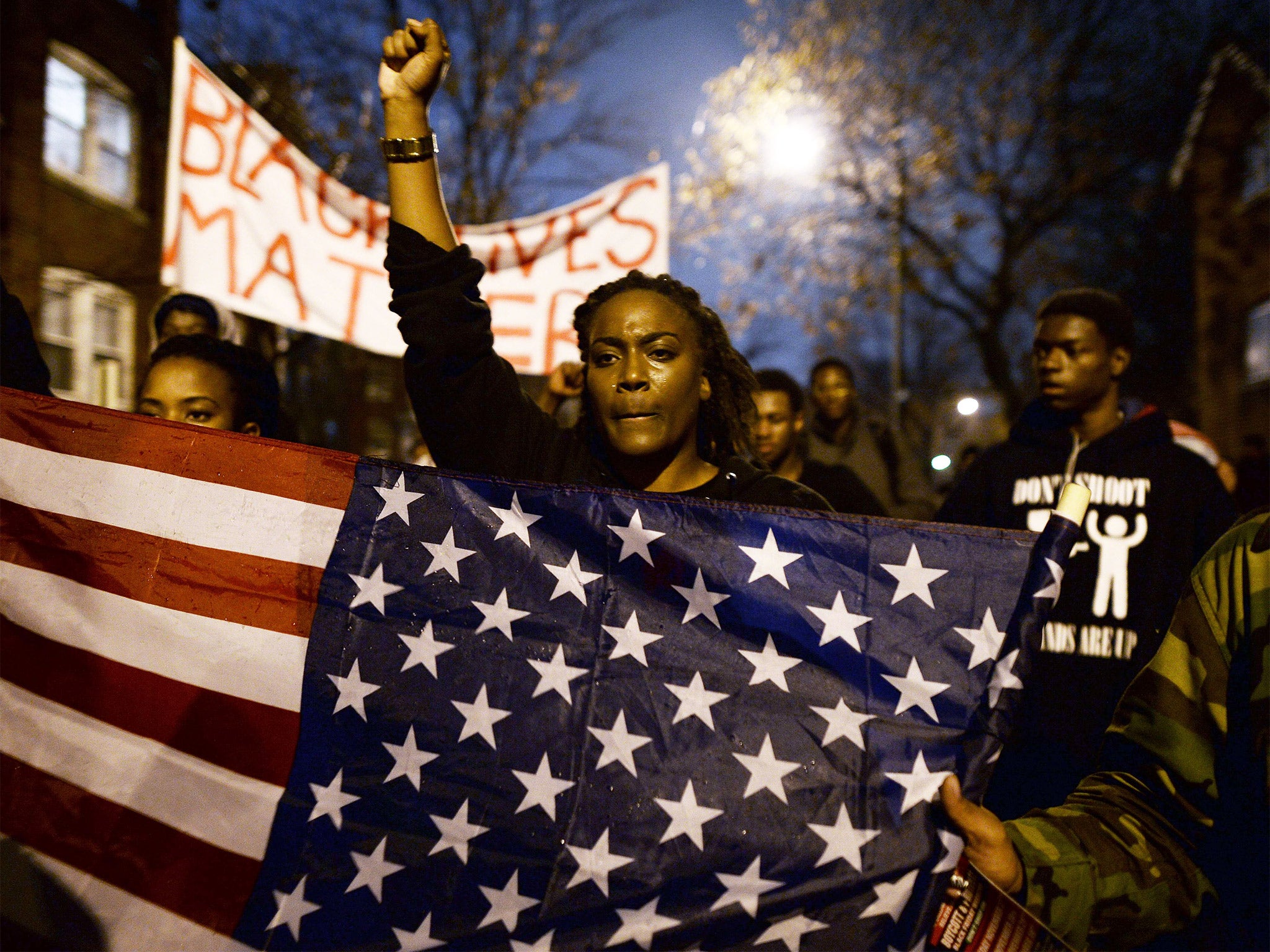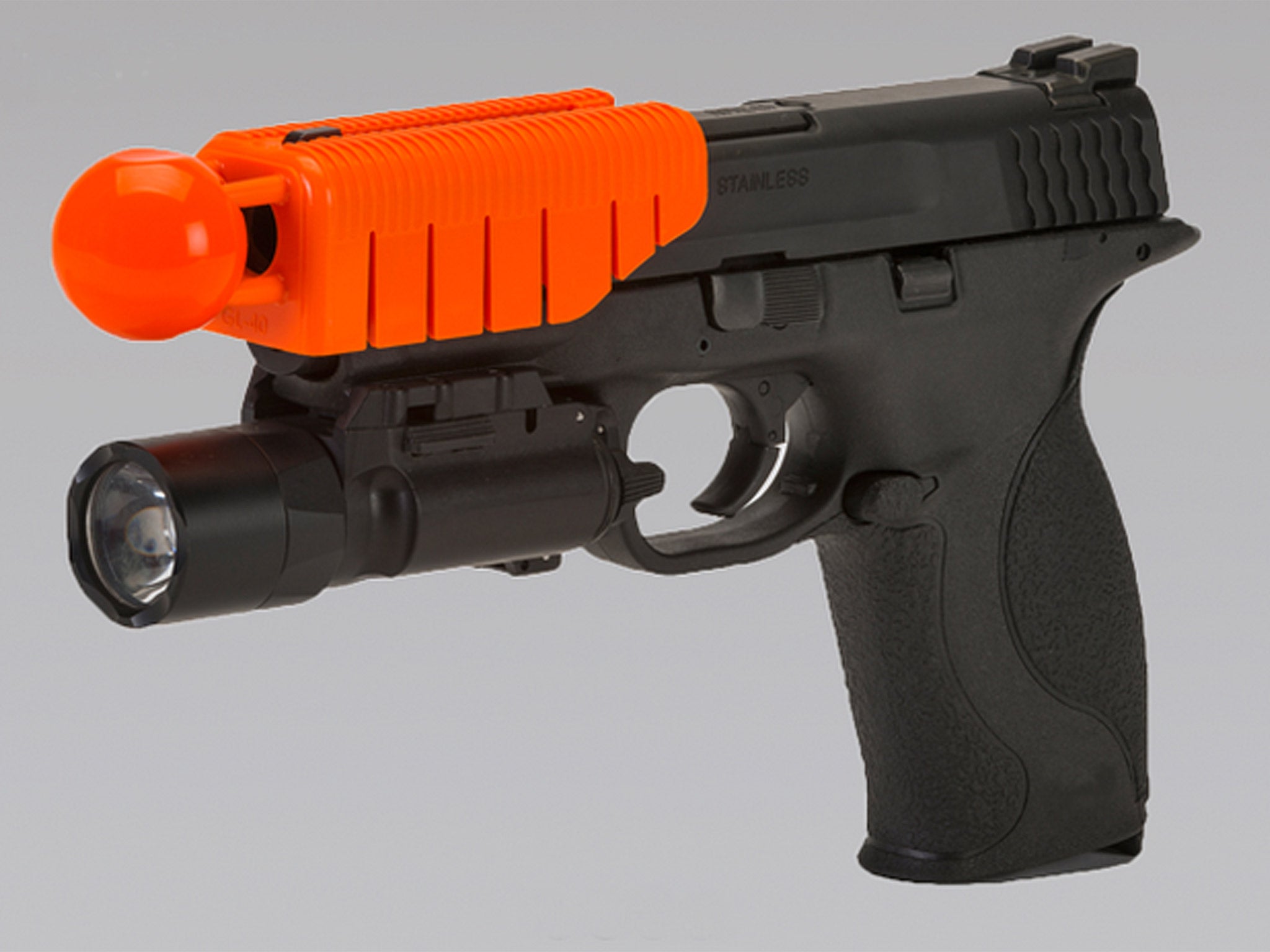Police in Ferguson are to test the non-lethal 'The Alternative' gun - but can it save lives?
The odd-looking, orange device can knock a person down but not kill them, according to the product's makers. This week, five police instructors in Ferguson will be trained to use the device

Your support helps us to tell the story
From reproductive rights to climate change to Big Tech, The Independent is on the ground when the story is developing. Whether it's investigating the financials of Elon Musk's pro-Trump PAC or producing our latest documentary, 'The A Word', which shines a light on the American women fighting for reproductive rights, we know how important it is to parse out the facts from the messaging.
At such a critical moment in US history, we need reporters on the ground. Your donation allows us to keep sending journalists to speak to both sides of the story.
The Independent is trusted by Americans across the entire political spectrum. And unlike many other quality news outlets, we choose not to lock Americans out of our reporting and analysis with paywalls. We believe quality journalism should be available to everyone, paid for by those who can afford it.
Your support makes all the difference.A month after a white officer fatally shot an unarmed black teenager in Ferguson, the city's assistant police chief, Al Eickhoff, took to Google and searched under the words "less lethal".
Eickhoff, a 36-year veteran of police work, said that he was looking for any new device, weapon or ammunition, any alternative to lethal force that might have prevented a deadly result when Michael Brown and Officer Darren Wilson encountered each other in the midday heat last August.
Browsing a Californian company's website, Eickhoff found pictures and videos of an odd-looking, orange device docked on a normal handgun barrel. When a bullet fired, it melded with an attached projectile the size of a ping-pong ball that flew with enough force to knock a person down, maybe break some ribs, but not kill them, the product's makers said – even at close range. Its name: the Alternative. This week, five police instructors in Ferguson will be trained to use the device; the department plans to introduce it to the entire force of 55 officers.
Attracting ardent fans and just-as-fierce critics, the Alternative is the latest in a growing inventory of less-than-lethal police weapons – including the Taser, bean-bag-loaded shotguns, pepper-filled pellets, rubber-coated bullets and stun grenades – that officers reach for in various situations to minimise the chances of killing people.
The difference is that the Alternative is meant for exactly the time when US officers decide, often in a split second, that they must shoot someone to protect themselves or others. "It gives another option," Eickhoff says of the device, which he later tested for himself. "I really liked it... You are always looking to save a life, not take a life."
But others consider the product dangerous because officers must take time – if only a few seconds – to remove it from their belts and affix it to a service weapon. That "exposes police officers to greater risk" and "turns policy on its head", says Steve James, a former police major and training expert from the same state.
"I am all about less lethal," he says. "What bothers me is we will allow an officer to face immediate deadly jeopardy with a less-lethal round. Deadly force is the most likely thing to repel deadly force."

Post-Ferguson, the issue is particularly fraught. Critics have accused law-enforcement agencies of inflicting casual brutality and needless death on minority communities. "Black lives matter" protests erupted across the US and Britain after a grand jury declined to charge Wilson in relation to Brown's death, and another grand jury, in Staten Island, did not indict the New York police officer who put Eric Garner in a fatal chokehold.
Then there was the harrowing surveillance video from Cleveland of a 12-year-old African-American boy, Tamir Rice, who was one moment nonchalantly playing with a pellet gun, the next moment shot dead by police.
Civil unrest catapulted deadly force on to the agenda of Barack Obama's new task force on police practices, created to help shore up public trust in America's criminal-justice system. But nobody can say how widespread police-involved deaths are in the US because police departments are not required to report that data. "The troubling reality is that we lack the ability right now to comprehensively track the number of incidents of either uses of force directed at police officers or uses of force by police," the Attorney General Eric Holder said last month. "This strikes many – including me – as unacceptable."
US police officials are quick to point out that the vast majority of officers would prefer to never have to shoot anyone. But juries almost always side with the judgements of those who enforce the law; if officers reasonably believe that they or others are in imminent danger of death or serious bodily harm, they are generally justified to shoot to kill.
That applies even if the suspect's gun was a replica or a mirage, a glint of light or a shadow, or if that now-bullet-riddled unarmed person was just reaching for his or her identification. It applies when a desperate character is waving a loaded gun, inviting "suicide by cop" – or just brandishing a big tree branch while marching on an officer.
Christian Ellis, the chief executive of Alternative Ballistics, says that he started his small company to perfect a device to stop needless citizen deaths. The rough concept was developed several years ago by a retired sheriff's officer from whom Ellis bought the patent.
"Ask a police officer what are the options when lethal force is justified and he'll say, 'I have my gun and my bullets,' " Ellis says. He calls the Alternative "an air bag for a bullet". Actually, it's a bulbous metal-alloy bullet‑capture device that travels up to 250ft per second (when propelled by a 9mm slug) and sends "a shock wave of pain through the suspect" when it hits, Ellis says. Effective to a range of 30ft, the Alternative incapacitates a person but would very rarely penetrate the skin, he says, citing ballistics tests using leather chamois, foam and gel to simulate the human body. All tests were conducted at a range of 5ft from muzzle to target.

Last month, Duncan Hunter, an Iraq war veteran who is now a congressman, whom Ellis invited to a shooting range for a demonstration of the device, sent letters to three federal law-enforcement agencies urging them to give "close consideration" to less-lethal bullet-capture devices that dock with a weapon. He did not specifically name the Alternative, but there appears to be nothing else fitting that description on the market.
Versions of the Alternative can be readily affixed to standard-issue pistols, but for now, no one knows how officers would perform with it under real-life stress. And no human being has been shot with it, Ellis says. The device captures the first bullet only; the next round chambered is a regular one – that is, lethal – so if the Alternative should fail to stop its target, the second slug could be discharged.
Some bloggers and gun enthusiasts have excoriated Ellis's product; one labelled it "terrifying", the worst less-lethal force idea ever. They have gleefully taken note that the business end of the Alternative resembles a clown's nose.
"I get this all the time from police until they see it and shoot it," Ellis says. "I've yet to have one person anywhere in the world who has shot it and not instantly believed in its value." He says that the device should never be an option when officers feel that they or those around them are immediately imperilled; then lethal force is obviously required.
"There's always this understandable tendency to find any kind of weapons that will cause the least amount of harm, to avoid deadly force," says Chuck Wexler, of the Police Executive Research Forum, who submitted testimony on the topic last week to the presidential task force. He was unfamiliar with the Alternative, but he noted that other supposedly less-lethal approaches, such as the Taser, can still cause severe injury or death. "The problem is when the technology gets too far out and advanced and there are not policies or guidelines."
So far, the Ferguson police department is the only US police agency that has decided to train with the Alternative. Its use must be approved by city officials. The units cost $45 (£30) each. "Hopefully we can get it on the streets soon," Eickhoff says. "Is it going to work every time? Probably no ... it's not a catch-all. Every situation is different. But it gives an officer, if time allows ... a chance to save a life instead of taking a life."
Could this thing have saved Brown? After a ruminative pause, Eickhoff says that if Wilson's fusillade of gunfire didn't stop Brown, it's not likely that a single-shot blunt-force projectile would have. "You could still shoot him with this round and he could still get up and come at you," Eickhoff says.
©Washington Post
Join our commenting forum
Join thought-provoking conversations, follow other Independent readers and see their replies
Comments